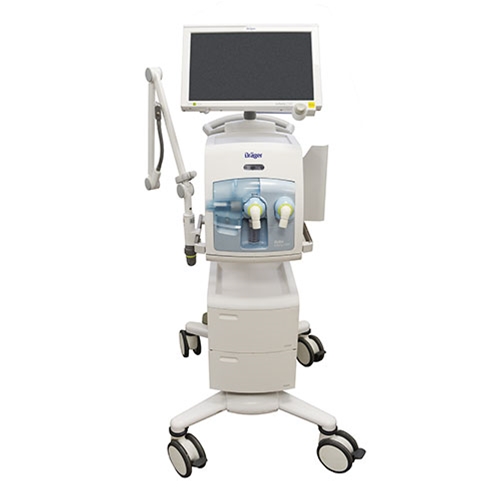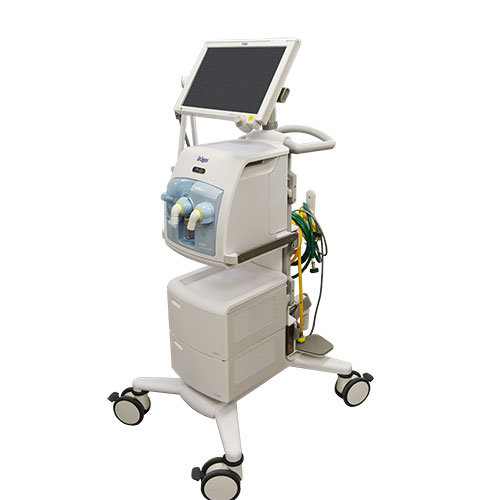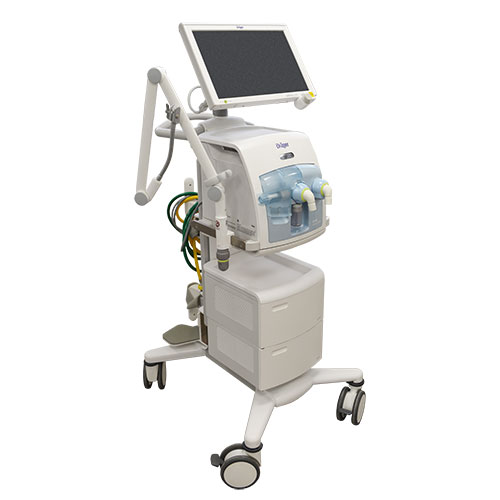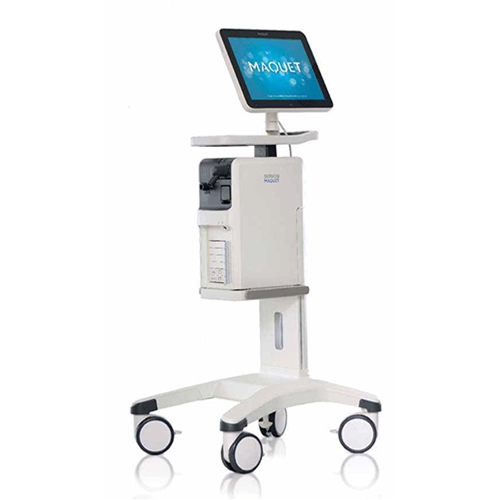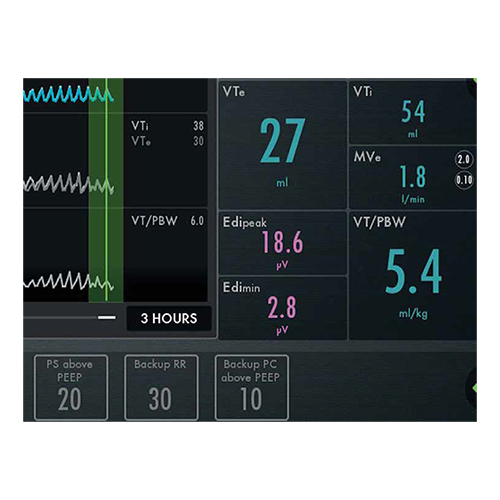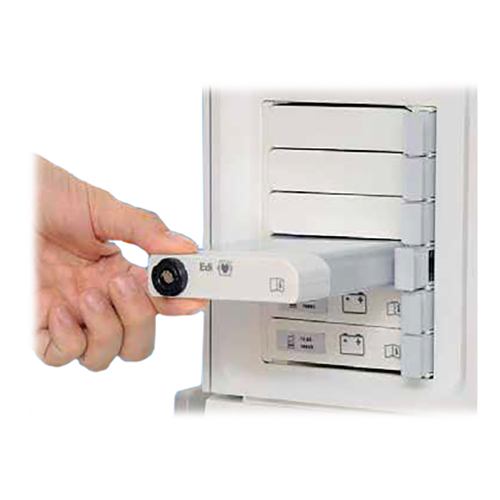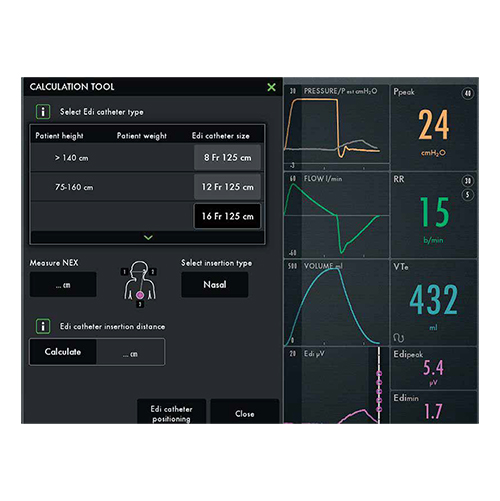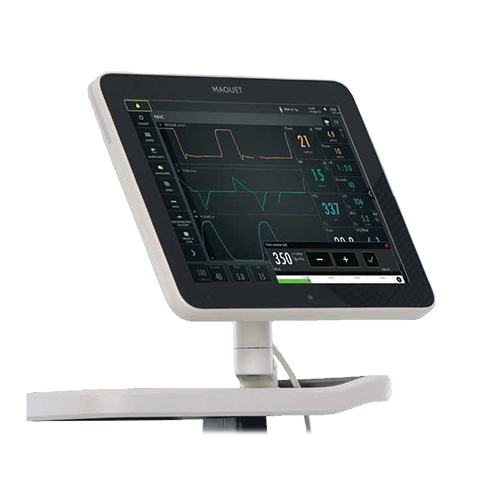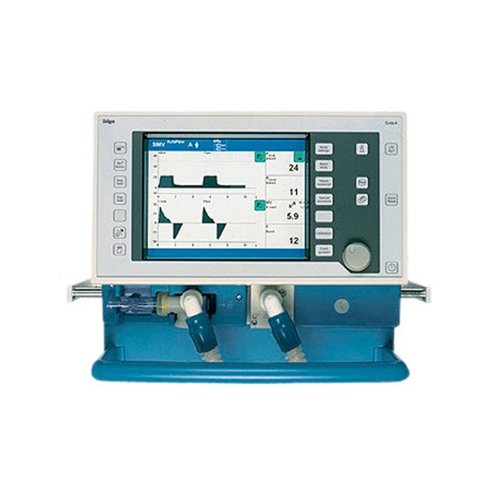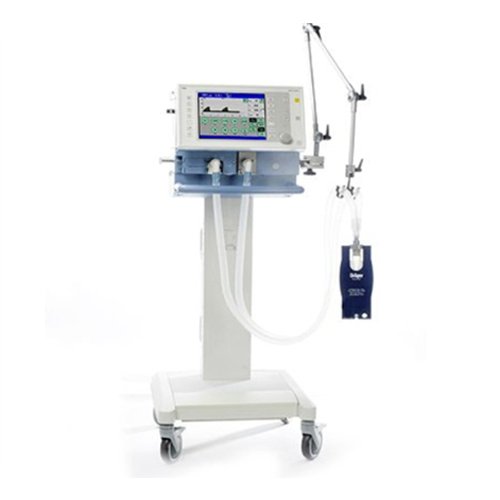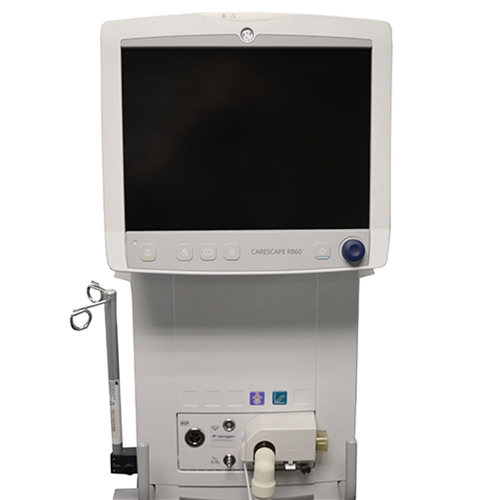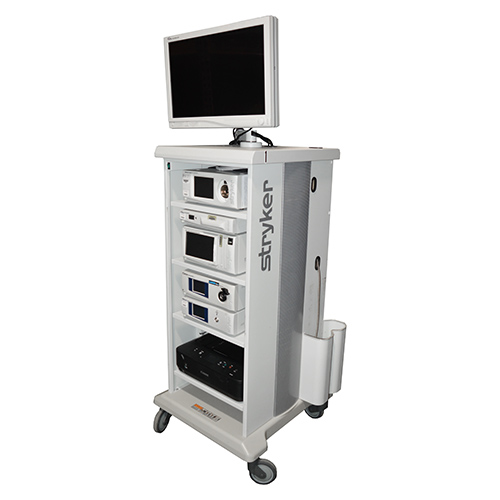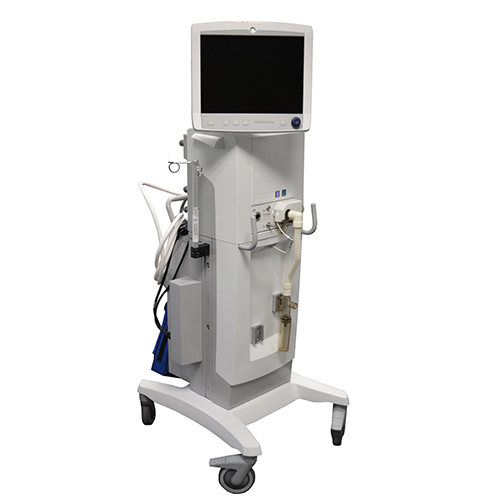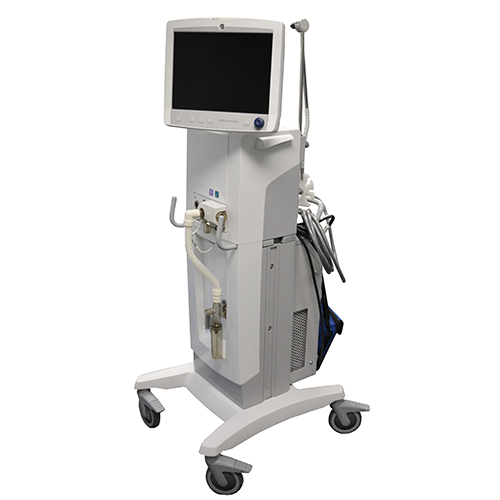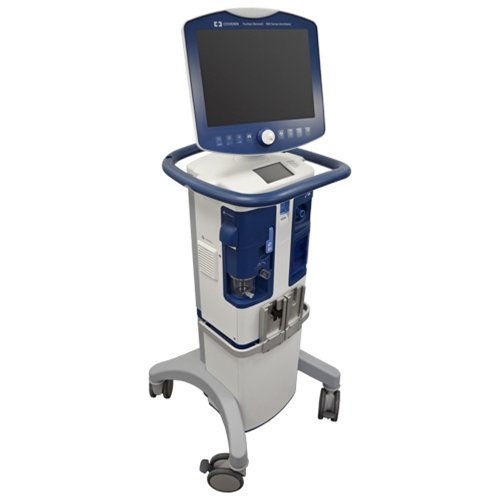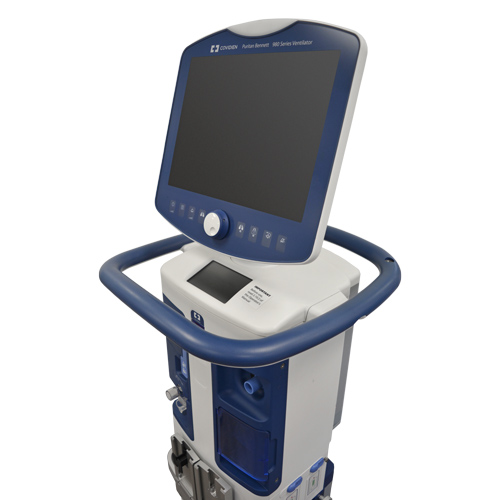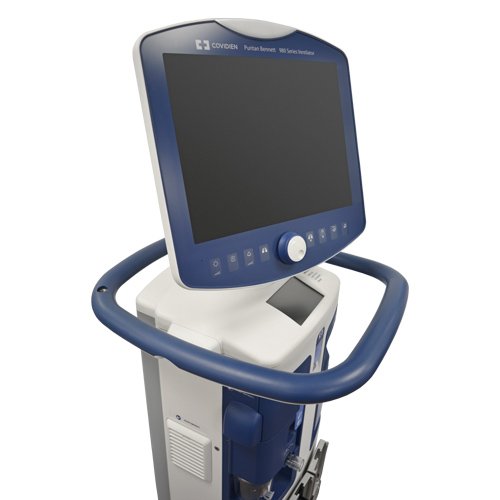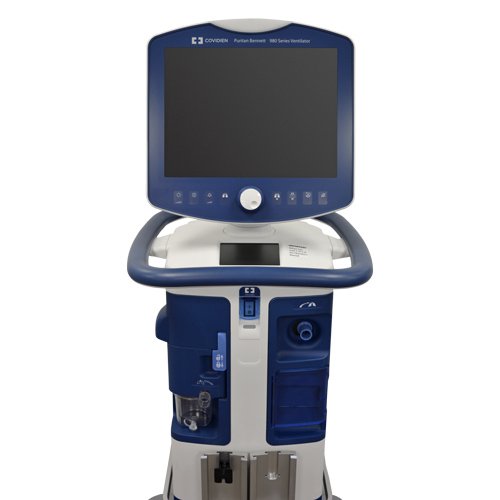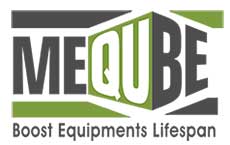DRAGER INFINITY V500
Features
The Drager Evita Infinity V500 can be used on adult, pediatric and neonatal patients. The Drager v500 is an advanced ventilation system that is used for acute respiratory support. Providing both invasive and Non-invasive ventilation along with comprehensive monitoring and treatment functions. The monitoring screen comes with an omnidirectional alarm bar, that can be seen from any point in the patient’s room. The Evita V500 Ventilator is recognized for its comprehensive patient -interface leakage. By compensating quickly by adjusting both triggers and termination points.
- Lung diagnostic tools like Low Flow.
- Volumetric CO2 Monitoring.
- Weaning parameters.
- Variable pressure support.
- Non-invasive ventilation in all modes and all patient categories.
- Data export via USB Interface.
- Flexible screen configurations.
Specifications
Dimensions
- Height: 55.3 in (142 cm)
- Width: 22.7 in (57.7 cm)
- Depth: 27.1 in (68.7 cm)
- Weight: 130 lbs. (59 kg)
Display
- Type: TFT color touch screen
- Size: 17” (43.2 cm) (Diagonal)
- Inputs/Outputs: 3 external RS232 (9-pin) connectors; 6 USB ports for data collection; 3 DVI for digital video output; 1 LAN port; 2 RJ 45 Ethernet connectors
Patient Types
- Adults, pediatric patients, and neonates
Ventilation Modes
- Volume Controlled Ventilation: VC-CMV, VC-SIMV, VC-AC, VC-MMV
- Pressure Controlled Ventilation: PC-CMV; PC-BIPAP1 / SIMV+; PC-SIMV; PC-AC; PC-APRV; PC-PSV
- Support of Spontaneous Breathing: SPN-CPAP/PS; SPN-CPAP/VS; SPN-CPAP; SPN-PPS
Enhancements
- AutoFlow / Volume Guarantee (VC-AC)
- Variable Pressure Support
- Smart Pulmonary View
- Automatic Tube Compensation (ATC)
- Mask Ventilation (NIV)
- SmartCare/PS 2.0 – Automated clinical protocol in SPN-CPAP/PS
- Low Flow PV Loop
- O2-therapy
Special Procedures
- Suction maneuver
- Manual inspiration/hold
- Medication nebulization
- P0.1
- PEEPi
- NIF
Therapy Types
- Invasive ventilation (Tube)
- Non-invasive ventilation (NIV)
- O2-therapy
Gas Supply
- O2 gauge pressure: 2.7 to 6.0 bar (or 270 to 600 kPa or 39 to 87 psi)
- Air gauge pressure: 2.7 to 6.0 bar (or 270 to 600 kPa or 39 to 87 psi)
Pressures
- Inspiratory pressure (Pinsp) 1 to 95 mbar (or hPa or cmH2O)
- Inspiratory pressure limit (Pmax) 2 to 100 mbar (or hPa or cmH2O)
- PEEP / intermittent PEEP (ΔintPEEP) 0 to 50 mbar (or hPa or cmH2O)
- Pressure assist (Psupp) 0 to 95 mbar (or hPa or cmH2O)
General
- Ventilation frequency (RR): Adult 0.5 to 98/min; Pediatric patients, Neonates 0.5 to 150/min
- Inspiration time (Ti): Adults 0.11 to 10 s; Pediatric patients, Neonates 0.1 to 10 s
- Tidal volume (VT): Adults 0.1 to 3.0 L; Pediatric patients 0.02 to 0.3 L; Neonates 0.002 to 0.1 L
- Inspiratory flow (Flow): Adults 2 to 120 L/min; Pediatric patients, Neonates 2 to 30 L/min
- Rise time for pressure assist (Slope): Adults, Pediatric patients 0 to 2 s; Neonates 0 to 1.5 s
- O2 concentration (FiO2): 21 to 100 Vol.%
- Trigger sensitivity (Flow trigger): 0.2 to 15 L/min
- O2 Therapy: Continuous Flow 2 to 50 L/min; O2 concentration FiO2 21 to 100 Vol%
- Automatic Tube Compensation (ATC): Inside tube diameter tube Ø
- Endotracheal tube ET: Adults 5 to 12 mm (0.2 to 0.47 inch); Pediatric patients 2 to 8 mm (0.08 to 0.31 inch); Neonates 2 to 5 mm (0.08 to 0.2 inch)
- Tracheostoma tube (Trach.): Adults 5 to 12 mm (0.2 to 0.47 inch); Pediatric patients 2.5 to 8 mm (0.1 to 0.31 inch)
- Degree of compensation 0 to 100 %
Airway Pressure Release Ventilation (PS-APRV)
- Inspiratory time (Thigh): 0.1 to 30 s
- Expiratory time (Tlow): 0.05 to 30 s
- Maximum time of low pressure level in APRV/PEF (Tlow max): 0.05 to 30 s
- Inspiratory pressure (Phigh): 1 to 95 mbar (or hPa or cmH2O)
- Expiratory pressure (Plow): 0 to 50 mbar (or hPa or cmH2O)
- Termination criterion (peak expiratory flow) (Exp. term.): 1 to 80 % (PEF)
Displayed Measured Values
- Plateau pressure (Pplat)
- Positive end-expiratory pressure (PEEP)
- Positive end-expiratory pressure (PIP)
- Mean airway pressure (Pmean)
- Minimum airway pressure (Pmin)
- Range -60 to 120 mbar (or hPa or cmH2O)
Minute Volume Measurement
- Expiratory minute volume (MVe)
- Inspiratory minute volume (MVi)
- Total minute volume (MV)
- Mandatory minute volume (MVmand)
- Spontaneous expiratory minute volume (MVspon)
- Range 0 to 99 L/min BTPS
Tidal volume measurement
- Tidal Volume (VT)
- Inspiratory tidal volume (not leakagecompensated) of mandatory breaths (VTimand)
- Expiratory tidal volume (not leakagecompensated) of mandatory breaths (VTemand)
- Inspiratory tidal volume (not leakagecompensated) of spontaneous breaths (VTispon)
- Range 0 to 5,500 mL BTPS
Respiratory rate measurement
- Breathing frequency (RR)
- Mandatory respiratory rate (RRmand)
- Spontaneous breathing frequency (RRspon)
- Range 0/min to 300/min
O2 measurement (inspiratory side)
- Inspiratory O2 concentration (FiO2)
- Range 18 to 100 Vol%
CO2 measurement in main flow (adults and pediatric patients only)
- End-expiratory CO2 concentration (etCO2)
- Range 0 to 100 mmHg
Displayed Calculated Values
- Compliance (C): Range 0 to 650 mL/mbar (or mL/cmH2O)
- Resistance (R): Range 0 to 1,000 mbar / (L/s) (or cmH2O / (L/s))
- Leakage minute volume (MVleak): Range 0 to 99 L/min
- Rapid Shallow Breathing (RSB): Range 0 to 9999 (/min/L)
- Negative Inspiratory Force (NIF): Range -80 mbar to 0 mbar (or hPa or cmH2O)
- Occlusion pressure P0.1: Range -60 to 130 mbar (or hPa or cmH2O)
- Curve displays: Airway pressure Paw (t) -30 to 100 mbar (or hPa or cmH2O); Flow (t) -180 to 180 L/min; Volume V (t) 2 to 3,000 mL; Exp. CO2 concentration (etCO2) 0 to 100 mmHg

